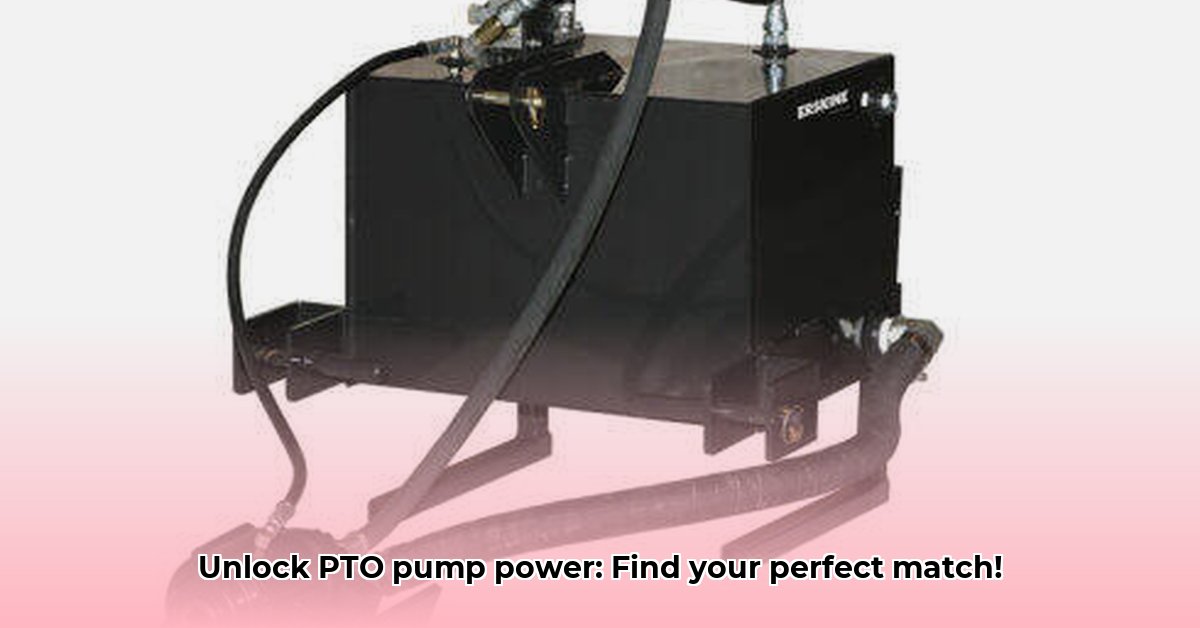
Hydraulic PTO Tractor Pumps: Understanding the Basics
Your tractor's hydraulic system relies on the PTO (Power Take-Off) hydraulic pump to convert engine power into the hydraulic pressure needed for various implements. Think of it as the engine driving all your attachments. The most common type is a gear pump, known for its ruggedness and suitability for most farm tasks. But a range of pump types exists, each with strengths and weaknesses. Understanding these differences is crucial for selecting the right pump for your needs. For more specialized PTO applications, check out this resource.
Different Types of PTO Hydraulic Pumps
While gear pumps dominate the market, other types offer distinct advantages:
| Pump Type | Advantages | Disadvantages | Ideal Uses |
|---|---|---|---|
| Gear Pump | Simple, reliable, relatively inexpensive, durable | Can be noisy, less efficient at high pressures | Most farm tasks, ideal for smaller operations |
| Vane Pump | Smooth operation, variable displacement | More complex, potentially pricier, more maintenance | Best for situations needing adjustable flow rates |
| Piston Pump | High pressure and efficiency | Complex, expensive, more maintenance intensive | Perfect for high-pressure jobs (e.g., large irrigation) |
Important Note: Comprehensive, long-term comparative data on these pump types is limited. More research is needed for a complete comparison. This guide focuses on readily available information and best practices.
Selecting the Right PTO Hydraulic Pump
Choosing the perfect pump involves careful consideration of several key factors:
Power Needs: Determine your implements' power requirements (flow rate in GPM – gallons per minute – and pressure in PSI – pounds per square inch). Insufficient power leads to poor performance; excessive power increases costs unnecessarily.
Application: Different implements have different needs. A bale wrapper demands a different pump than a fertilizer spreader. Match the pump's specifications to the intended use. Heavy-duty applications require heavier-duty pumps.
Budget: Higher-end pumps offer better efficiency and longevity, but initial costs are higher. Consider the long-term cost of ownership, including potential replacements.
Tractor Compatibility: Ensure your tractor's PTO speed matches the pump's specifications. Mismatches can cause damage.
Installing Your PTO Hydraulic Pump: A Step-by-Step Guide
Professional installation is recommended; however, here's a general overview:
Step 1: Safety First! Always disconnect the tractor's PTO and hydraulic system. Wear safety glasses and gloves.
Step 2: Secure Mounting: Mount the pump to a sturdy part of the tractor's frame, following the manufacturer's instructions precisely.
Step 3: PTO Connection: Carefully align and connect the pump's PTO shaft to your tractor's PTO shaft. Accurate alignment prevents damage.
Step 4: Hydraulic Lines: Connect the hydraulic lines, ensuring correct flow direction. Consult the pump's manual for detailed instructions.
Step 5: Testing and Verification: After installation, briefly run the system; check for leaks and correct operation.
Operation, Maintenance, and Troubleshooting
Regular maintenance is crucial for a long-lasting pump:
Fluid Levels: Regularly check and maintain the correct hydraulic fluid level and condition, using the manufacturer's recommended type and grade.
Leaks: Immediately address any leaks to prevent further damage.
Filters: Keep hydraulic system filters clean and replace them according to the manufacturer's schedule.
Wear Plates: Inspect wear plates regularly, even on self-adjusting systems.
Common problems and solutions:
No Pressure: Check fluid levels, filters, and PTO engagement. A damaged pump is a possibility.
Low Pressure: Check fluid levels and filters. Worn wear plates or internal pump damage could be the cause.
Leaks: Inspect seals and connections; replace as needed.
Excessive Noise: This might indicate worn bearings or gears.
Always consult your owner's manual, and seek professional help when necessary. Ignoring problems leads to more extensive and costly repairs.
Choosing the Right Pump: A Decision Tree
This decision tree helps guide your pump selection:
| Question | Answer | Pump Choice |
|---|---|---|
| Primary Application? | Light-duty (spraying, seeding) | Lower GPM, lower PSI, smaller HP |
| Primary Application? | Heavy-duty (manure spreading, tilling) | Higher GPM, higher PSI, higher HP |
| Tractor's PTO Capacity? | Limited horsepower | Pump matched to available horsepower |
| Budget? | Lower cost | More cost-effective materials and models |
| Priority? | Durability | Cast iron construction |
| Priority? | Weight | Aluminum construction |
Remember, proper selection, installation, and maintenance are critical for the long-term efficiency and performance of your PTO hydraulic pump.
Additional Considerations
Mounting Location: Consider mounting the pump directly on the implement for simplified maintenance and reduced stress on the tractor's frame. However, this adds complexity to the hydraulic system.
Material Selection: Cast iron provides superior durability, especially under heavy loads, but weighs more. Aluminum offers lighter weight but may need more frequent replacement. Consider the trade-offs for your specific needs.
By carefully considering these factors and following the guidelines in this guide, you can ensure you choose, install, and maintain a PTO hydraulic pump that maximizes efficiency and minimizes downtime on your farm.